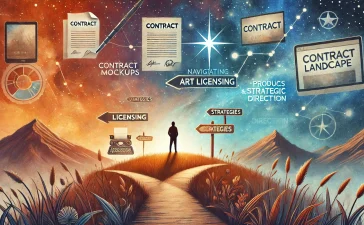Greeting cards remain a timeless way to connect with others, and for artists and designers, they offer a fantastic opportunity to showcase creativity while reaching a wide audience. If you’re looking to break into the greeting card industry or expand your current portfolio, this guide will walk you through the process of submitting your artwork or designs to card manufacturers and publishers.
Step 1: Research the Market
Before you start creating or submitting designs, it’s crucial to understand the greeting card market:
- Visit card shops and online stores to see current trends
- Note which publishers and manufacturers are producing cards that align with your style
- Observe seasonal trends and popular themes
Step 2: Develop Your Style
While versatility is valuable, having a distinctive style can make your work stand out:
- Experiment with different mediums and techniques
- Create a cohesive portfolio that showcases your unique artistic voice
- Consider how your style might adapt to different card themes
Step 3: Create a Diverse Portfolio
Publishers often look for artists who can work across various themes. Your portfolio should include designs for:
- Birthday
- Wedding and Anniversary
- Baby and New Parent
- Sympathy and Get Well
- Thank You
- Congratulations
- Holiday (Christmas, Easter, Valentine’s Day, etc.)
- Friendship
- Graduation
- Retirement
- Thinking of You
- Blank/All-Occasion
Remember, your artwork doesn’t always have to be theme-specific. Sometimes, a beautiful piece of art can be adapted to different themes with the addition of appropriate text.
Step 4: Prepare Your Submissions
Different companies have different submission requirements, but generally:
- Create high-quality scans or photographs of your artwork
- Prepare digital files in common formats (JPEG, TIFF, PDF)
- Organize your work into themed collections
- Consider creating mock-ups of how your art might look on a card
Step 5: Research Submission Guidelines
Each publisher or manufacturer will have specific guidelines:
- Visit company websites or contact them directly for submission information
- Note any specific themes or styles they’re currently seeking
- Pay attention to preferred file formats and sizes
- Check if they accept email submissions or require physical mailings
Step 6: Craft a Professional Submission Package
Your submission should include:
- A cover letter introducing yourself and your work
- Your portfolio or samples (as per the company’s guidelines)
- Your contact information and website/social media links
- A brief artist statement or bio
Step 7: Follow Up and Be Patient
After submitting:
- Keep track of where and when you’ve submitted
- Follow up politely if you haven’t heard back within the stated timeframe
- Be prepared for rejections and use them as learning opportunities
- Continue creating and improving your portfolio while you wait
Step 8: Understand Licensing and Contracts
If a company is interested in your work:
- Carefully read any contracts or licensing agreements
- Understand the terms of use and compensation
- Don’t be afraid to ask questions or seek legal advice if needed
Additional Tips for Success:
- Stay Current: Keep up with trends in the greeting card industry and popular culture.
- Be Versatile: While having a signature style is great, being able to adapt to different themes and styles can increase your chances of success.
- Think Seasonally: Create designs for major holidays and seasons well in advance (companies often work 6-12 months ahead).
- Consider Text Placement: Leave space in your designs for text to be added later.
- Understand the Market: Different demographics prefer different styles. Research who buys greeting cards and what they’re looking for.
- Quality Over Quantity: It’s better to submit a smaller number of high-quality designs than a large number of mediocre ones.
- Be Professional: Treat your submissions like job applications. Be polite, follow guidelines, and present yourself professionally.
- Network: Attend trade shows, join artist groups, and connect with others in the industry.
The Unexpected Theme Phenomenon
It’s important to note that sometimes manufacturers or publishers may see potential in your artwork that you didn’t initially envision. For example, a still life painting that you never considered as a greeting card design might catch a publisher’s eye as perfect for a “Thinking of You” card.
This phenomenon occurs because experienced card publishers have a keen understanding of what resonates with card buyers. They might see elements in your artwork – perhaps the mood, color palette, or composition – that align perfectly with a particular sentiment or occasion.
For instance:
- A serene landscape might become a sympathy card
- A vibrant abstract piece could be transformed into a celebration card
- A detailed botanical illustration might find new life as a thank you card
This is why it’s crucial to submit a diverse range of your best work, even if you don’t immediately see its potential as a greeting card. Publishers often have the vision to pair the right artwork with the right sentiment, creating a product that resonates with buyers.
When submitting your work, consider including a mix of:
- Theme-specific designs (explicitly created for particular occasions)
- Non-specific beautiful artwork (that could be adapted to various themes)
- Experimental or unique pieces (that might inspire unexpected card ideas)
By providing a wide range of your work, you increase the chances of a publisher finding something that sparks their creativity and fits their current needs.
Conclusion
Submitting your artwork or designs for greeting cards can be an exciting venture into a new market for your creativity. By following these steps and tips, you’ll be well-prepared to present your work professionally and increase your chances of success in the greeting card industry.
Remember, persistence is key. Many successful card designers faced numerous rejections before finding their place in the market. Keep creating, keep improving, and keep submitting. Your unique artistic voice has the potential to touch people’s lives through the timeless medium of greeting cards.
- Find out more
- Launch Pad + Accelerator Expressions of Interest
- Selling and Licensing Your Art & Designs Around the World with ArtSHINE.
- Looking for exciting new Art and Designs to license.
We’re here to help you to take action, just like we’ve helped thousands of other entrepreneurs, business owners, and creative professionals all around the globe.
Now is the time to let your passion SHINE.
Now is the time to Make Tomorrow Today!
To your success, Vinh Van Lam and Stuart Horrex Cofounders ArtSHINE.com






Great detailed advice!